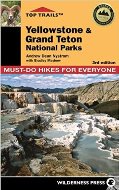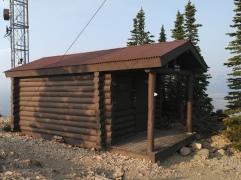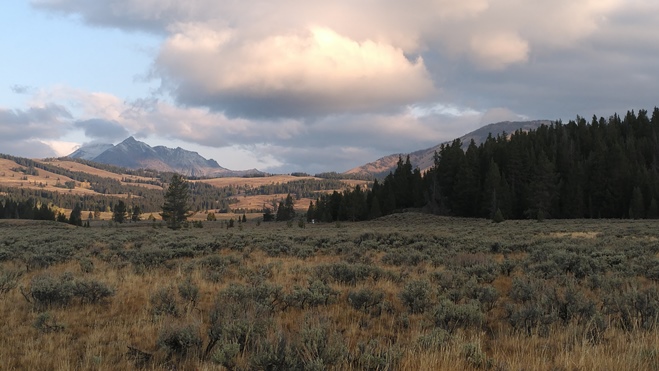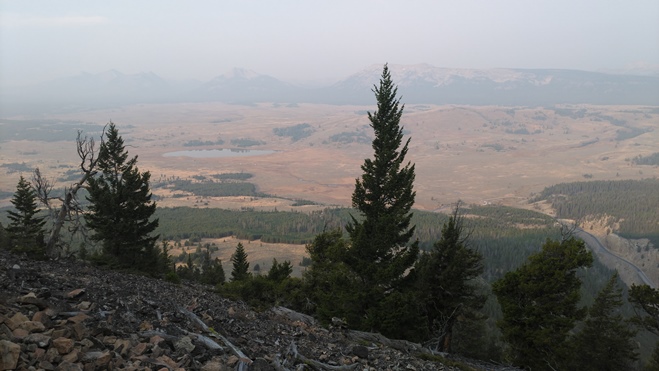
Bunsen Peak
| Trail Features: | Outstanding Views, Wildlife |  |
|||
| Trail Location: | Mammoth | ||||
| Roundtrip Length: | 4.4 Miles | ||||
| Trailhead Elevation: | 7278 Feet | ||||
| Total Elevation Gain: | 1286 Feet | ||||
| Avg. Elev Gain / Mile: | 585 Feet | ||||
| Highest Elevation: | 8564 Feet | ||||
| Trail Difficulty Rating: | 6.97 (moderate) | ||||
| Parking Lot Latitude | 44.93216 | ||||
| Parking Lot Longitude | -110.72783 | ||||
Trail Description:
The hike to Bunsen Peak begins from the Bunsen Peak Trailhead, located roughly 5 miles south of Mammoth on Grand Loop Road in Yellowstone National Park. Look for a gravel parking lot on the east side of the road, just south of Golden Gate.
In order to beat the crowds we arrived at the trailhead at the break of dawn. As a result, we were treated to the sound of wolves howling from three different directions as we prepared for our hike. At the same time we could hear at least one bull elk bugling near the base of the peak. The bugling could be heard all the while we ascended the mountain, as well as at the summit.
Hikers should note that the park website warns that grizzly bears are known to frequent this area. Thus, it’s a good idea to hike in groups of at least three, make lots of noise, and carry bear spray on this hike.
Almost immediately the trail begins to climb, and at just under a mile from the parking lot it begins to ascend the mountain itself. As you proceed higher you’ll begin ascending a series of short switchbacks along the northwestern and northern slopes of the mountain. From the trailhead to the summit the path meanders in and out of forested areas. While passing through open areas hikers will enjoy great views of Swan Lake Flats and the Gallatin Mountain Range towards the west, as well the Golden Gate and Mammoth Hot Springs areas towards the north. Though there are some steep sections along the route, the climb is moderately strenuous, with virtually no exposure to any steep drop-offs.

At roughly 2.1 miles hikers will reach the radio cabin atop the peak. Also located here are antennas and other communication equipment that serve Mammoth and other nearby communities. Though you may think you’ve reached the highest point on the mountain, this is technically a false summit. The true summit is located another tenth-of-a-mile towards the south. Here you’ll find four concrete tower footings. These likely supported a fire lookout that once stood atop the mountain in the mid-1900s, and was possibly constructed around 1940, according to a Salt Lake Tribune article. Although there’s very little information available on the internet, it appears that the lookout stood atop the peak until at least 1957. One photo I found shows it to be a low wooden structure, resting on four concrete footings.

Although there are quite a few trees at the summit, you’ll still enjoy panoramic views of the surrounding area. In addition to Swan Lake Flats and the Gallatin Mountains towards the west, hikers will also enjoy birds-eye views of Blacktail Deer Plateau and the Yellowstone River Valley towards the east.
From a geological standpoint, Bunsen Peak is an ancient volcanic cone. Fittingly, the mountain is named for Robert Bunsen, a German chemist who studied volcanic activity in Iceland during the mid-1800s, and became famous as the inventor of the Bunsen Burner. The first documented ascent of the peak was made by Ferdinand V. Hayden and Captain John W. Barlow during the first Hayden Geologic Survey in 1871.
Additional Resources:
* Yellowstone National Park website
* Trail Map (trails are not included on the official park map)
* Lonely Planet Yellowstone & Grand Teton National Parks